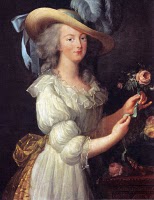Phrases & Expressions - Then Let Them Eat Cake!
 Wednesday, February 4, 2009 at 1:08PM Tweet
Wednesday, February 4, 2009 at 1:08PM Tweet  You’ve probably heard the story about how Marie-Antoinette, when told that her subjects were starving for lack of bread, replied, “Then let them eat cake.” Right?
You’ve probably heard the story about how Marie-Antoinette, when told that her subjects were starving for lack of bread, replied, “Then let them eat cake.” Right?
Don’t believe it. It’s a mis-attribution, if it was ever uttered at all.
Some historians attribute this phrase to Maria Teresa, the Spanish Infanta who married Louis XIV more than 100 years before. Others say it was never spoken, but written by Jean-Jacques Rousseau in book six of his 12-volume autobiographical work, Confessions. He writes:
At length I recollected the thoughtless saying of a great princess, who, on being informed that the country people had no bread, replied, ‘Then let them eat pastry!’
Of course, Rousseau may have been thinking of Maria Teresa, he didn't say. But since Marie-Antoinette arrived at the Palace of Versailles in 1770, three years after Rousseau had published the above passage, whoever the "great princess" was that he recollected, it was certainly not Marie-Antoinette.
History has always seen its share of spin-doctoring. Either this phrase was falsely attributed to Marie-Antoinette during the French Revolution expressly to make her look bad. Or it made her look bad after-the-fact in its English translation. Let me explain:
The French phrase was: "qu'ils mangent de la brioche”, and could just as well have meant, “Then let them buy brioche for the same price as bread.” This would have allowed the poor to enjoy what would otherwise have been unaffordable. A sensible solution during a bread shortage, Non?
Sources:
Fraser, Antonia. Marie Antoinette: The Journey. London: Phoenix Paperbacks, 2001.
http://www.phrases.org.uk/
Image:
Élisabeth-Louise Vigée-Le Brun (16 April 1755 - 30 March 1842) is recognized as the most famous woman painter of the 18th century. She was a personal favorite of Marie-Antoinette and painted many images of the Queen.
 1 Comment | |
1 Comment | |  Email Article |
Email Article |  Print Article | tagged
Print Article | tagged  French Revolution,
French Revolution,  Marie-Antoinette |
Marie-Antoinette |  Permalink
Permalink 






